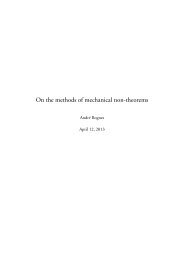The passive voice in written and spoken Scandinavian
The passive voice in written and spoken Scandinavian
The passive voice in written and spoken Scandinavian
You also want an ePaper? Increase the reach of your titles
YUMPU automatically turns print PDFs into web optimized ePapers that Google loves.
fiction. <strong>The</strong> <strong>passive</strong> <strong>voice</strong> is found <strong>in</strong> 25% of the f<strong>in</strong>ite verbs <strong>in</strong> academic prose <strong>and</strong><br />
only a little more <strong>in</strong> fiction than <strong>in</strong> conversations (Biber et al. 1999: 476).<br />
<strong>The</strong> Oslo Corpus of Tagged Norwegian Texts (Bokmål part) makes it possible<br />
to search separately with<strong>in</strong> different genres—factual prose (ma<strong>in</strong>ly legal texts),<br />
fiction <strong>and</strong> newspaper texts. Results from the Oslo Corpus <strong>in</strong>dicate large differences<br />
between the genres <strong>in</strong> Norwegian, <strong>and</strong> correspond well <strong>in</strong> this way with the f<strong>in</strong>d<strong>in</strong>gs<br />
for English. <strong>The</strong> relative frequency of the <strong>passive</strong> <strong>voice</strong> <strong>in</strong> the legal text corpus is<br />
20.4%, whereas the correspond<strong>in</strong>g figure for fiction texts amounts to only 1.9%.<br />
It seems safe to conclude that the overall use of the <strong>passive</strong> <strong>voice</strong> <strong>in</strong> the three<br />
Sc<strong>and</strong><strong>in</strong>avian languages is relatively similar. <strong>The</strong> <strong>passive</strong> <strong>voice</strong> is used primarily <strong>in</strong><br />
<strong>written</strong> language, whereas its use <strong>in</strong> speech is significantly less frequent. In this<br />
respect Norwegian seems to be somewhat different from the two other languages, as<br />
<strong>passive</strong> constructions <strong>in</strong> <strong>spoken</strong> Norwegian occur only half as frequently as <strong>in</strong> Danish<br />
<strong>and</strong> Swedish.<br />
3.2 Distribution of morphological <strong>and</strong> periphrastic <strong>passive</strong>s<br />
When look<strong>in</strong>g at the distribution of morphological <strong>and</strong> periphrastic <strong>passive</strong>s <strong>in</strong> Table<br />
5, some <strong>in</strong>terest<strong>in</strong>g differences emerge. In the <strong>written</strong> register the morphological<br />
<strong>passive</strong> is the ma<strong>in</strong> <strong>passive</strong> form <strong>in</strong> all three languages. In Swedish the form is<br />
overwhelm<strong>in</strong>gly dom<strong>in</strong>ant. Hence, a full 98.7% of all <strong>passive</strong> occurrences <strong>in</strong> the<br />
Swedish sample are morphological <strong>passive</strong>s, leav<strong>in</strong>g only 1.3% for periphrastic<br />
constructions. In Danish <strong>and</strong> Norwegian the differences are less pronounced. Both<br />
languages use the morphological form <strong>in</strong> roughly two-thirds of the cases <strong>and</strong><br />
periphrastic constructions <strong>in</strong> about one-third.<br />
<strong>The</strong> distribution of the different <strong>passive</strong> forms changes quite dramatically<br />
when we look at the <strong>spoken</strong> language. Danish <strong>and</strong> Norwegian are quite similar. In<br />
both languages the periphrastic <strong>passive</strong> becomes more common than the<br />
morphological form, account<strong>in</strong>g for 76.9% <strong>in</strong> Danish <strong>and</strong> for 79.6% <strong>in</strong> Norwegian.<br />
<strong>The</strong> same tendency shows up <strong>in</strong> the Swedish material. In <strong>spoken</strong> Swedish, the use of<br />
periphrastic <strong>passive</strong> constructions <strong>in</strong>crease with a factor of 12 compared to the<br />
<strong>written</strong> language. It accounts for 15.8% of the <strong>passive</strong> constructions <strong>in</strong> speech,<br />
compared to 1.3% <strong>in</strong> <strong>written</strong> language. <strong>The</strong> morphological <strong>passive</strong> rema<strong>in</strong>s, however,<br />
the dom<strong>in</strong>ant form <strong>in</strong> Swedish, account<strong>in</strong>g for 84.2% of all <strong>passive</strong> constructions.<br />
18

















